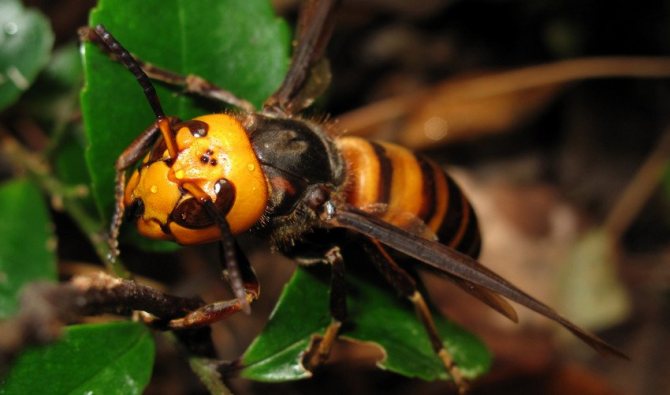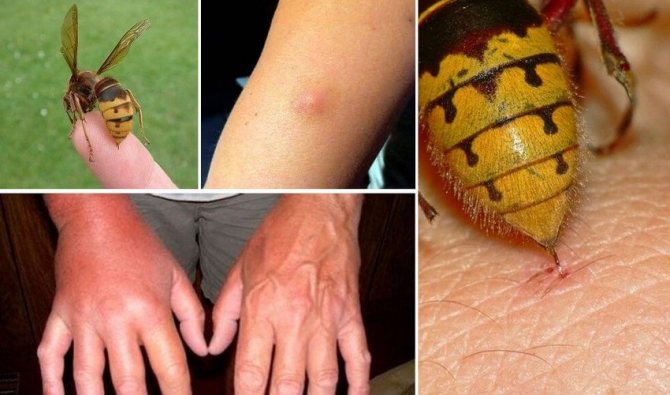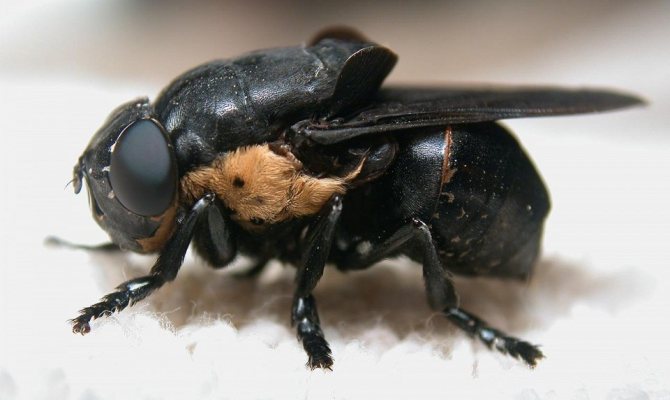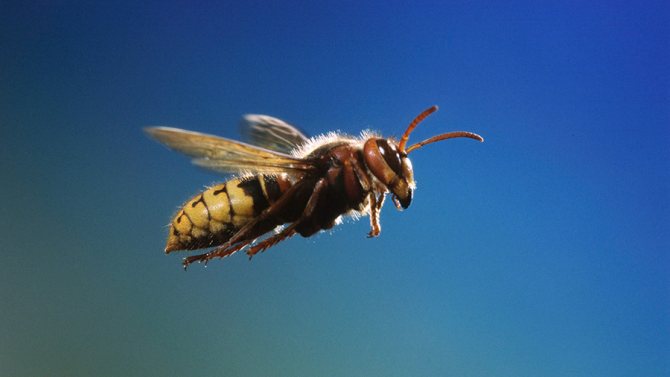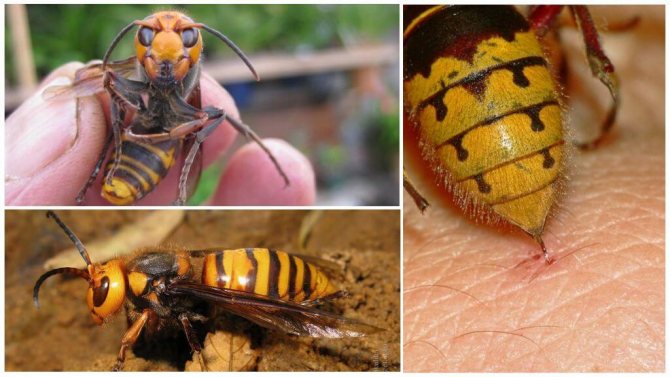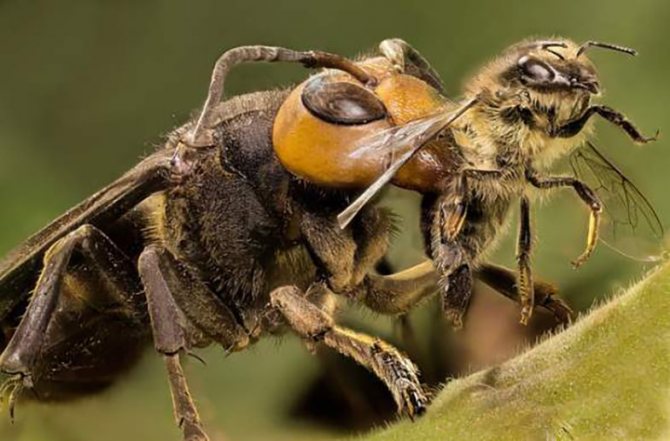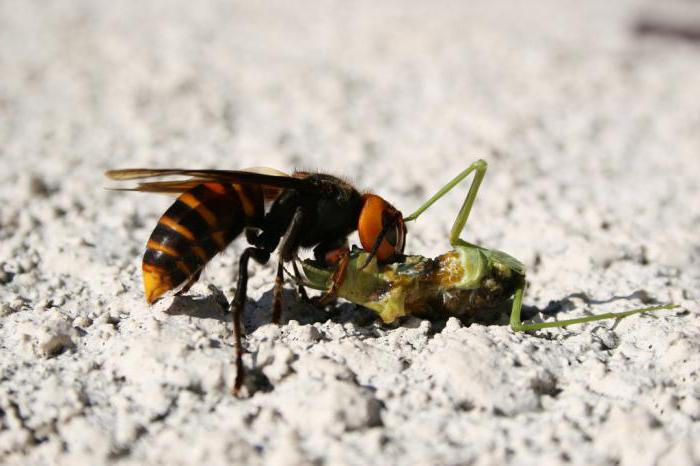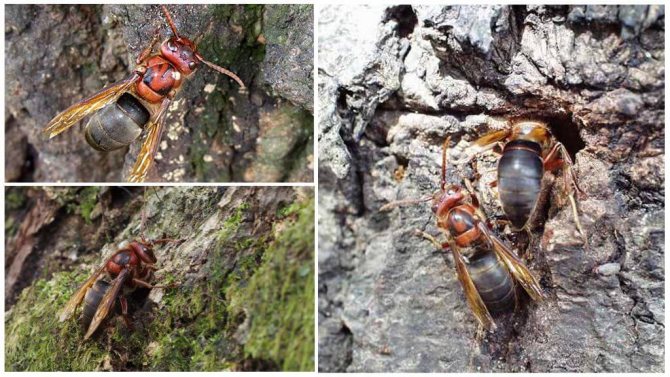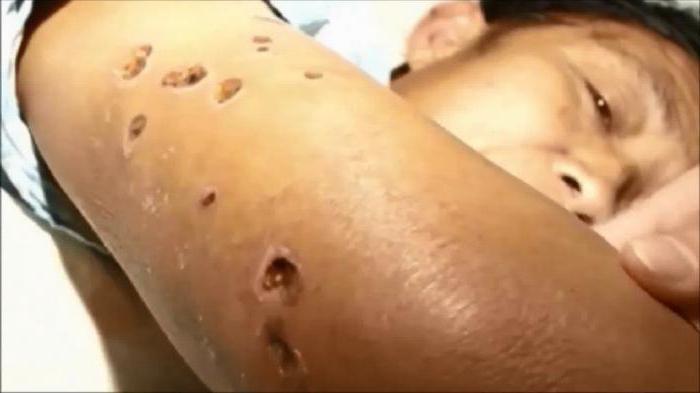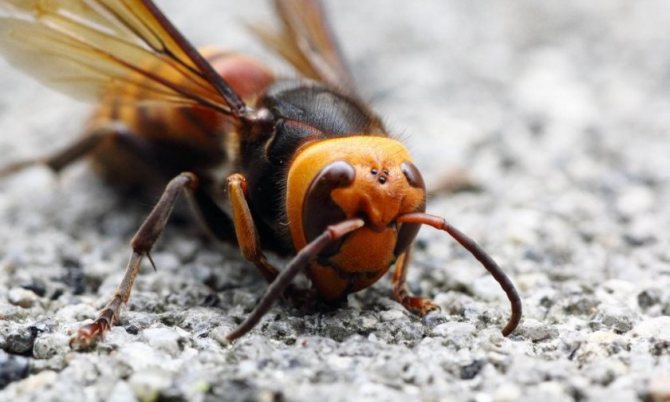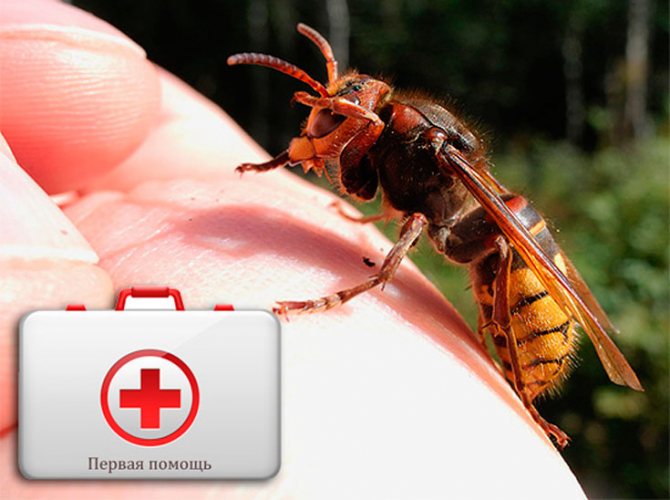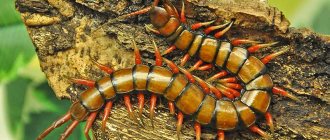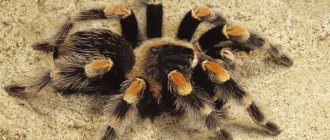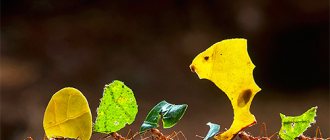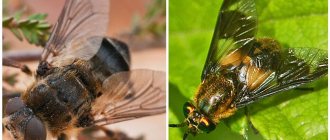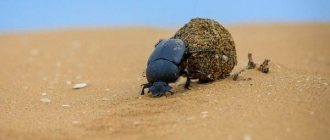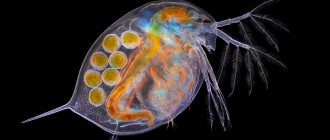
The Japanese huge hornet is a close relative of the Common Hornet that lives in our country. But, despite this, the difference in appearance and size between these insects is simply enormous.
Comparing them, you can see that the Japanese hornet differs from its European counterpart in color, however, this is far from its main characteristic feature. Dimensions - this is what this giant can boast of. This insect has its name "giant Japanese hornet" for a reason: its body length can exceed 4 cm, and its wingspan is 6 cm.
The photo below shows the Japanese hornet (Vespa mandarina japonica):


And this is what an ordinary hornet (Vespa crabro) looks like, which is widespread in Russia and Europe:
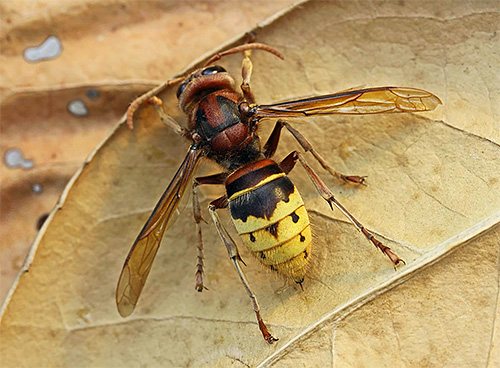

Perhaps the first thing that comes to mind at the sight of a Japanese "monster" is how dangerous it is and how painful its bite is. Indeed, the giant hornet has a very frightening appearance, which, however, accurately reflects the seriousness of the consequences of meeting with him.
Japanese hornets can indeed be very dangerous: in the country that gave the name to these insects, more than 40 people die from their bites every year. All the people this hornet has ever stung claim that they have never experienced a more painful bite in their life.
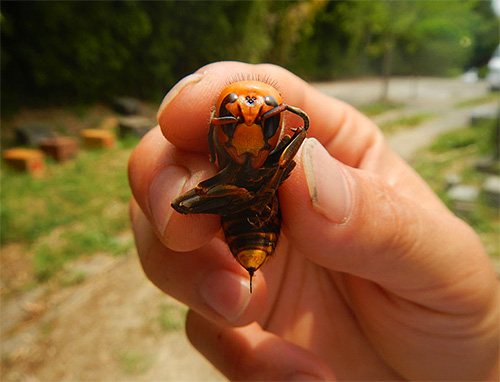

On a note
Almost any meeting with a hornet, no matter what species it belongs to, is to one degree or another dangerous. It is not surprising that medical scientists and biologists were greatly interested in the effect of the bites of these insects on the human body. It turned out that in nature one of the strongest is the poison possessed by the giant Japanese hornet: even with a single bite, it can cause a powerful allergic reaction, including anaphylactic shock. With a massive attack of several hornets of this species, a person can experience severe hemorrhages and tissue necrosis.
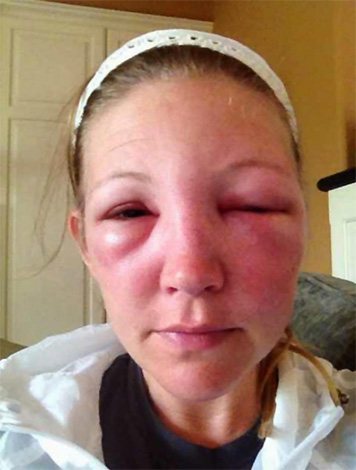

When planning a trip to Japan, it is useful to always be prepared for a chance encounter with giant hornets and to know not only how they look, but also how to behave so that insects do not attack.
Insect features
The huge Japanese hornet, referred to as the "sparrow bee", does not at all resemble a friendly bird. Moreover, the stinging insect has a very aggressive character.
Vespa mandarinia japonica (giant Japanese hornet) differs from its counterparts not only in color, but also in large size:
- It is an insect up to 5 cm, whose wingspan reaches 6-7 cm.
- Outwardly, the giant is very similar to a wasp: it has a segmented body with yellow-brown stripes, a black chest. The yellow-orange head has two large eyes and three additional accessory eyes. A photo of the Japanese hornet is presented below.
- Another characteristic feature of the insect is its powerful jaws, with the help of which the Japanese hornet is able to harm an enemy even larger than itself.
- The giant's main weapon is a very long sting (more than 6 mm). With its help, the Japanese hornet inflicts a painful blow, letting in a poison that has a neuroparalytic effect in its victim. Moreover, only females have this organ.
On a note!
The strongest poison of the giant is capable of causing a serious allergy even with a single bite; some victims develop anaphylactic shock. The consequence of massive attacks of representatives of this species can be various hemorrhages and tissue necrosis.
Description of Vespa mandarinia
Outwardly, the giant Asian hornet bears a resemblance to the common European hornet. They both have 3 extra small eyes on their heads for better orientation in space, including in the dark, as well as black and yellow stripes on the back of the body. However, this is perhaps all. They have much more differences:
- the most noticeable difference is size (Asian is larger);
- black stripes on the back of the body of the Asian hornet are wider than yellow ones (in contrast to its European counterpart);
- the color of the front part of the body of the "Asian" is darker than that of the "European", and even with a black pattern on the back;
- two large lateral eyes are almost black, while the common European hornet has a lighter brownish shade;
- the head of most subspecies of the Asian hornet is bright yellow (or orange), which immediately catches the eye.


The lifestyle and nutrition of the Japanese giant
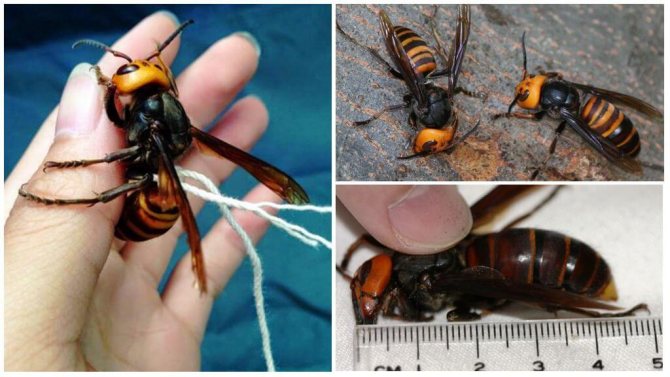

Giant japanese hornet
Each individual in the hive has its own responsibilities. The "leading position" is occupied by the queen uterus, who is the continuer of the clan. The delivery of food is handled by hornets workers. Going in search of her, workers can travel several kilometers.
Food for giant hornets is not only fruits and sugar-containing vegetables, but also insect pests of agricultural crops, as well as honey bees. Having found a bee hive, the hornet marks it with an odorous liquid, which allows him to subsequently return to the find with his fellows. During the attack, the giants in the literal sense of the word dismember the body of their victims, trying to extract valuable meat from them. Having dealt with adults, tyrants take the larvae and honey, which also serve them as food.
Interesting!
It will take no more than a minute for a Japanese hornet to exterminate up to 4 dozen bees. In 3 hours, 3 dozen individuals can destroy the entire bee family.
Thunderstorm of all bees
The huge hornet delivers the most trouble to Japanese beekeepers. Honey bees (usually European varieties, more industrious and less aggressive) are a real delicacy for hornets. However, the prey is not only bees, but also the honey they produce, which the giant predator regards after the ruin of the hive.


It is interesting
A single giant hornet can kill up to thirty bees in a minute, and a group of 30-40 "aggressors" destroys a bee colony of 20-25 thousand individuals in a few hours.
If a scout hornet finds a dwelling hive with bees, he leaves odorous marks near it, and upon returning to the nest shows his fellows the way to a delicacy. After that, the killer hornets are already sent in a whole detachment to destroy the hive.


In fairness, it should be noted that some species of bees, in turn, also have a unique mechanism for dealing with hornets. However, it gives results only with a small number of attackers. If hornets attack in significant numbers, bees, alas, are powerless.
So how does the bee's defense mechanism work? Hive defense consists of several stages:
- at the very beginning, when a giant hornet tries to enter the hive, several bees stick around it;
- further - others sit on them, and this continues until a huge, up to 30-35 cm in diameter, ball of bees grows around the hornet;
- in parallel with this process, all the defenders of the hive actively move their wings, directing the air into the ball - towards the aggressor - and heating it to 46-47 ° C, which is fatal for the hornet (the bees themselves can withstand heating up to 50 ° C).
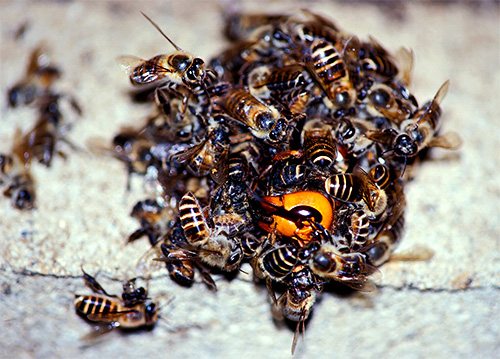

The result of all these efforts is the death of the attacking predator from overheating within about one hour.
Despite such a seemingly effective mechanism, bees are not able to cope with a whole squad of winged killers. That is why the Japanese giant hornet is considered the cause of serious losses for the beekeeping farms of this country. Owners and workers of apiaries do their best to destroy hornet nests near honey hives.
It is also useful to read: About the peculiarities of the life of black hornets and the danger to humans
Nevertheless, the struggle of beekeepers against an enemy insect often ends in failure: a huge hornet, due to its size, can fly away in search of food at a distance of up to 10 km from its nest, and chase the victim itself up to 5 km. Therefore, in spite of all human efforts, the destruction of the nests of a giant predator often does not give pronounced results when protecting apiaries.
Where the giant hornet lives
By the name of the insect, it becomes clear that the birthplace of the huge Japanese hornet is Japan. Outside this country, the giant can be found only in the southern part of Sakhalin Island. When choosing a habitat, insects prefer quiet, cozy places, building nests in hollows and on tree branches, in cracks in rocks and under eaves of buildings. The cocoon of a giant hornet is very similar to a hornet's nest; it is distinguished from the latter only by its large dimensions.
Rules of conduct near nests
The Asian huge hornet is not a solitary predator, but settles in colonies. Feeling a threat, he begins to secrete a hormone that notifies other individuals of danger and gives a signal to attack.
Therefore, being near the hive, you cannot:
- make sudden movements,
- knock on trees,
- disturb the nest itself,
- panic and try to escape.
It is very dangerous to kill a hornet near his house, since during the death the insect manages to transmit an alarm signal, which provokes representatives of his family to aggression. All this can provoke a hornet attack and lead to rather sad consequences.
Respectful attitude towards other inhabitants of our planet will help maintain balance in nature and prevent the attack of a dangerous predator.
How does it multiply
In the spring, a fertilized female builds a nest from the bark of branches, which she crushes with her powerful jaws. The queen uterus moistens wood particles with the secretion of the salivary glands, as a result of which the composition takes the form of rough paper.
Of the 3 hundred eggs laid by the female, larvae appear in 7-10 days. After three molts, they pupate. A month later, a young hornet emerges from the pupa. He can not only independently find food for himself, but also take care of the larvae that have appeared.
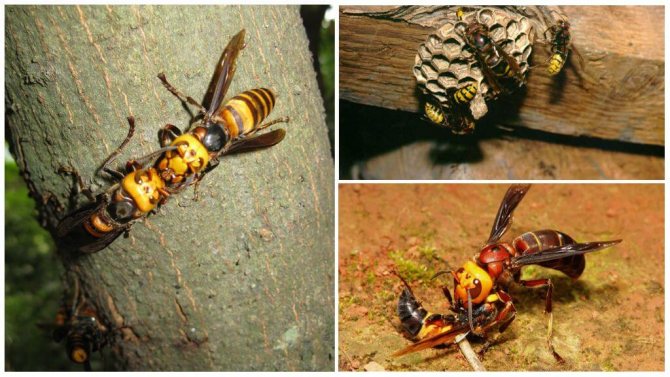

Giant japanese hornet
Interesting!
Only males develop in unfertilized eggs. Future successors of the family occupy more spacious and comfortable cells.
With an increase in the number of individuals in the family, the dimensions of the nest also increase. Young individuals begin to mate, future queens of the uterus go in search of a favorable place for building a nest, and males die with the approach of cold weather. With the arrival of warmth, the females wake up and begin the construction of a new shelter.
Reproduction
The Asian hornet reproduces in several stages. The highlights of this process are:
- The families of these large bees "live" for one year.
- As the dwelling grows, the number of working hornets also increases. The uterus then lays eggs again to reproduce breeding individuals.
- After reaching puberty, females and males mate, then males die, and females move to secluded places, where they remain until spring. With the onset of warmth, they form new colonies.
- By the beginning of the rainy season (in Primorye this coincides with the beginning of the winter period), the old colony dies out, as the uterus makes more eggs.
However, many Vespa hornets do not live up to the last stage, a large number die from infection, parasites.
Bite symptoms
A Japanese hornet bite is accompanied by:
- strong pain;
- the occurrence of extensive redness and swelling in the area of damage to the skin;
- heart palpitations and headache;
- high body temperature and swollen lymph nodes;
- shortness of breath and nausea.
Giant hornets are able to repeatedly sting their prey and for this they do not have to sit on the skin at all.
The ingestion of histamine (a compound that causes allergies) into human blood is especially dangerous for hypersensitive people. Therefore, they urgently need to provide medical assistance.
Important!
Pre-medical actions consist in applying a cold compress to the bite site and taking an antihistamine.
What are dangerous for humans
With a giant Asian hornet, it is better for a person not to meet in a bad way. The bite of this insect is very dangerous not only for health, but sometimes for life, because it is Vespa Mandarinia that is sometimes called the killer hornet. Its poison is one of the most toxic among all insects.
In countries where this species is widespread, dozens of human deaths from its bites are recorded every year.
Conventionally, you can be glad that, like other hornets, the Asian does not release all of its poison at once, but injects it "in portions", about 2 mg per bite. However, this amount is sometimes more than enough to get a lot of problems and dire consequences. It is scary to imagine what the body's reaction will be in the case of multiple bites and the introduction of a correspondingly larger amount of poison of such a high toxicity!


With a single sting for a person with strong immunity and without allergy to the components of the poison, there should be no serious consequences, at least fatal. However, for the more weakened or allergy sufferers, everything is much more complicated. It is also dangerous that a previously healthy person can sometimes quite unexpectedly react inadequately to poison: a once non-existent allergy suddenly developed. This may be due to the high content of histamine in the venom. In such cases, each subsequent bite will be harder and harder to bear.


